reset MERCEDES-BENZ C-Class COUPE 2014 CL204 Owner's Manual
[x] Cancel search | Manufacturer: MERCEDES-BENZ, Model Year: 2014, Model line: C-Class COUPE, Model: MERCEDES-BENZ C-Class COUPE 2014 CL204Pages: 342, PDF Size: 4.55 MB
Page 6 of 342
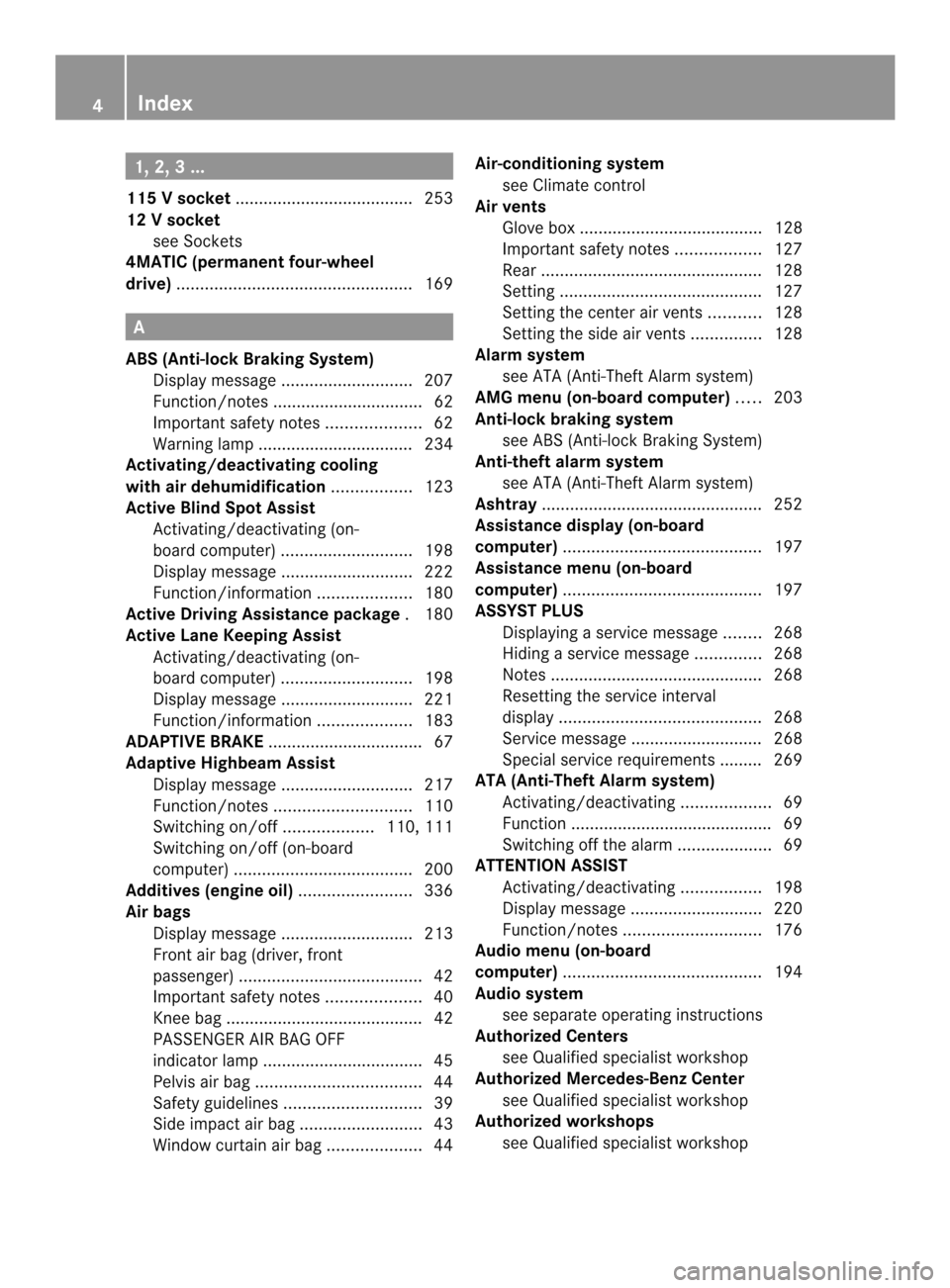
1, 2, 3 ...
115 Vsocket ...................................... 253
12 Vsocket
see Sockets
4MATIC (permanent four-wheel
drive) .................................................. 169A
ABS (Anti-lock Braking System) Display message ............................ 207
Function/notes ................................ 62
Important safety notes ....................62
Warning lamp ................................. 234
Activating/deactivating cooling
with air dehumidification .................123
Active Blin dSpot Assist
Activating/deactivating (on-
board computer) ............................ 198
Display message ............................ 222
Function/informatio n.................... 180
Active Driving Assistance package .180
Active Lane Keeping Assist Activating/deactivating (on-
board computer) ............................ 198
Display message ............................ 221
Function/informatio n.................... 183
ADAPTIVE BRAKE ................................. 67
Adaptive Highbeam Assist Display message ............................ 217
Function/notes ............................. 110
Switching on/off ...................110, 111
Switching on/off (on-board
computer) ...................................... 200
Additives (engine oil) ........................336
Airb ags
Display message ............................ 213
Front air bag (driver, front
passenger )....................................... 42
Important safety notes ....................40
Knee bag .......................................... 42
PASSENGER AIR BAG OFF
indicator lamp .................................. 45
Pelvis airb ag................................... 44
Safety guidelines ............................. 39
Side impact airb ag.......................... 43
Windo wcurtain air bag .................... 44Air-conditioning system
see Climate control
Airv ents
Glove box ....................................... 128
Important safet ynotes .................. 127
Rea r............................................... 128
Setting ........................................... 127
Setting the center air vents ...........128
Setting the side air vents ...............128
Alarm system
see ATA (Anti-Theft Alarm system)
AMG menu (on-board computer) .....203
Anti-loc kbraking system
see ABS (Anti-lock Braking System)
Anti-theft alarm system
see ATA (Anti-Theft Alarm system)
Ashtray ............................................... 252
Assistance display (on-board
computer) .......................................... 197
Assistance menu (on-board
computer) .......................................... 197
ASSYST PLUS Displaying a service message ........268
Hiding a service message ..............268
Notes ............................................. 268
Resetting the service interval
displa y........................................... 268
Service message ............................ 268
Special service requirements ......... 269
ATA (Anti-Theft Alarm system)
Activating/deactivating ...................69
Function .......................................... .69
Switching off the alarm ....................69
ATTENTIO NASSIST
Activating/deactivating .................198
Display message ............................ 220
Function/notes ............................. 176
Audio menu (on-board
computer) .......................................... 194
Audio system see separate operating instructions
Authorized Centers
see Qualified specialist workshop
Authorized Mercedes-Benz Center
see Qualified specialist workshop
Authorized workshops
see Qualified specialist workshop 4
Index
Page 14 of 342
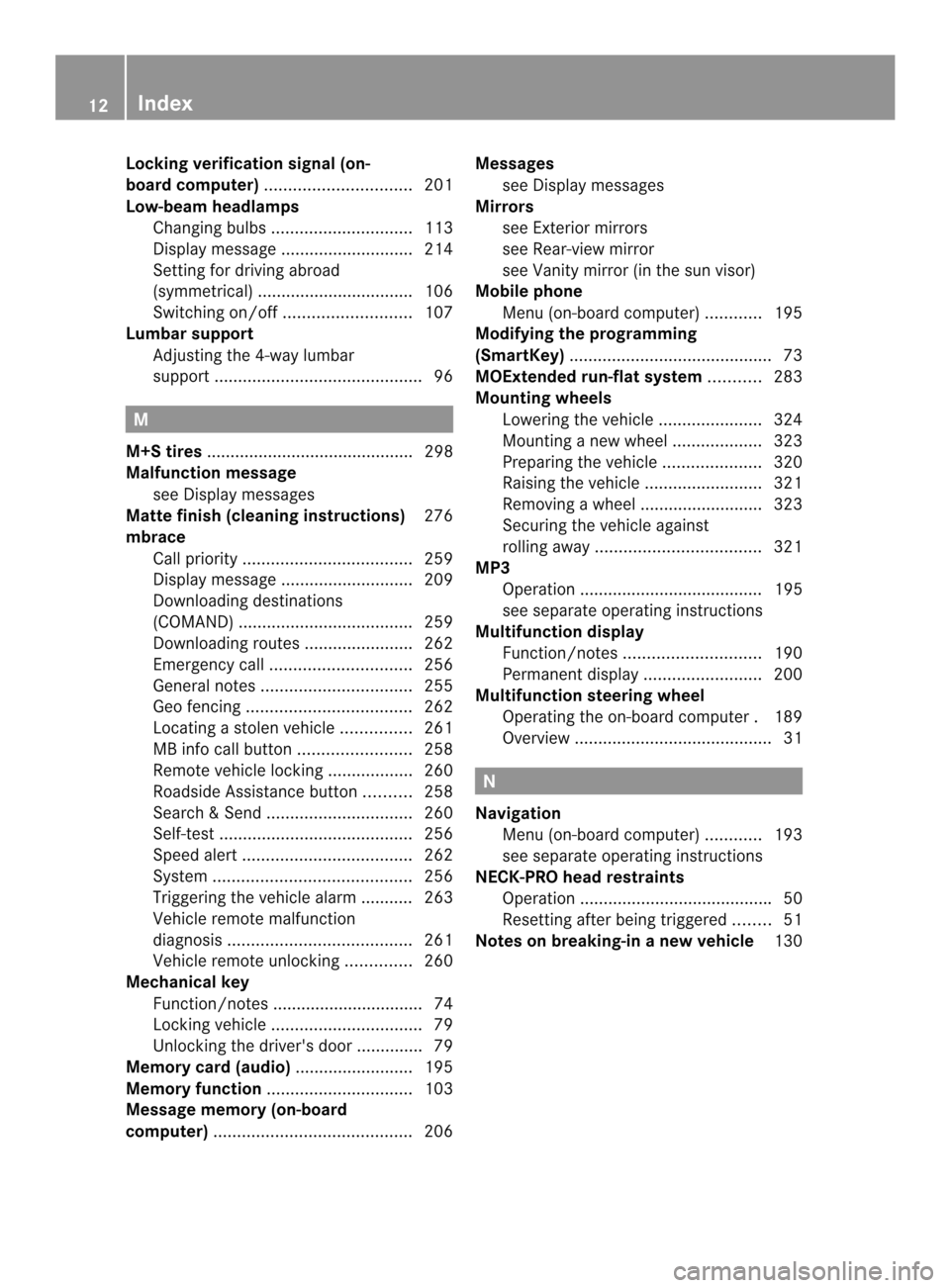
Locking verification signal (on-
board computer)
............................... 201
Low-beam headlamps Changing bulbs .............................. 113
Display message ............................ 214
Setting for driving abroad
(symmetrical) ................................. 106
Switching on/off ........................... 107
Lumbar support
Adjusting the 4-way lumbar
support ............................................ 96M
M+S tires ............................................ 298
Malfunction message see Display messages
Matte finish (cleaning instructions) 276
mbrace Call priority .................................... 259
Display message ............................ 209
Downloading destinations
(COMAND) ..................................... 259
Downloading route s....................... 262
Emergency call .............................. 256
General notes ................................ 255
Geo fencing ................................... 262
Locating astolen vehicl e............... 261
MB info call button ........................258
Remote vehicle locking ..................260
Roadside Assistance button ..........258
Search &Send ............................... 260
Self-test ......................................... 256
Speed alert .................................... 262
System .......................................... 256
Triggering the vehicle alarm ........... 263
Vehicle remote malfunction
diagnosi s....................................... 261
Vehicle remote unlocking ..............260
Mechanical key
Function/notes ................................ 74
Locking vehicle ................................ 79
Unlocking the driver's door ..............79
Memory card (audio) .........................195
Memory function ............................... 103
Message memory (on-board
computer) .......................................... 206Messages
see Display messages
Mirrors
see Exterior mirrors
see Rear-view mirror
see Vanity mirror (in the sun visor)
Mobile phone
Menu (on-board computer) ............195
Modifying the programming
(SmartKey) ........................................... 73
MOExtended run-flat system ...........283
Mounting wheels Lowering the vehicle ......................324
Mounting anew wheel ................... 323
Preparing the vehicle .....................320
Raising the vehicle .........................321
Removing awheel .......................... 323
Securing the vehicle against
rolling away ................................... 321
MP3
Operation ....................................... 195
see separate operating instructions
Multifunction display
Function/notes ............................. 190
Permanent displa y......................... 200
Multifunction steering wheel
Operating the on-board computer .189
Overview .......................................... 31 N
Navigation Menu (on-board computer) ............193
see separate operating instructions
NECK-PRO head restraints
Operation ........................................ .50
Resetting after being triggered ........51
Notes on breaking-in anew vehicle 13012
Index
Page 15 of 342
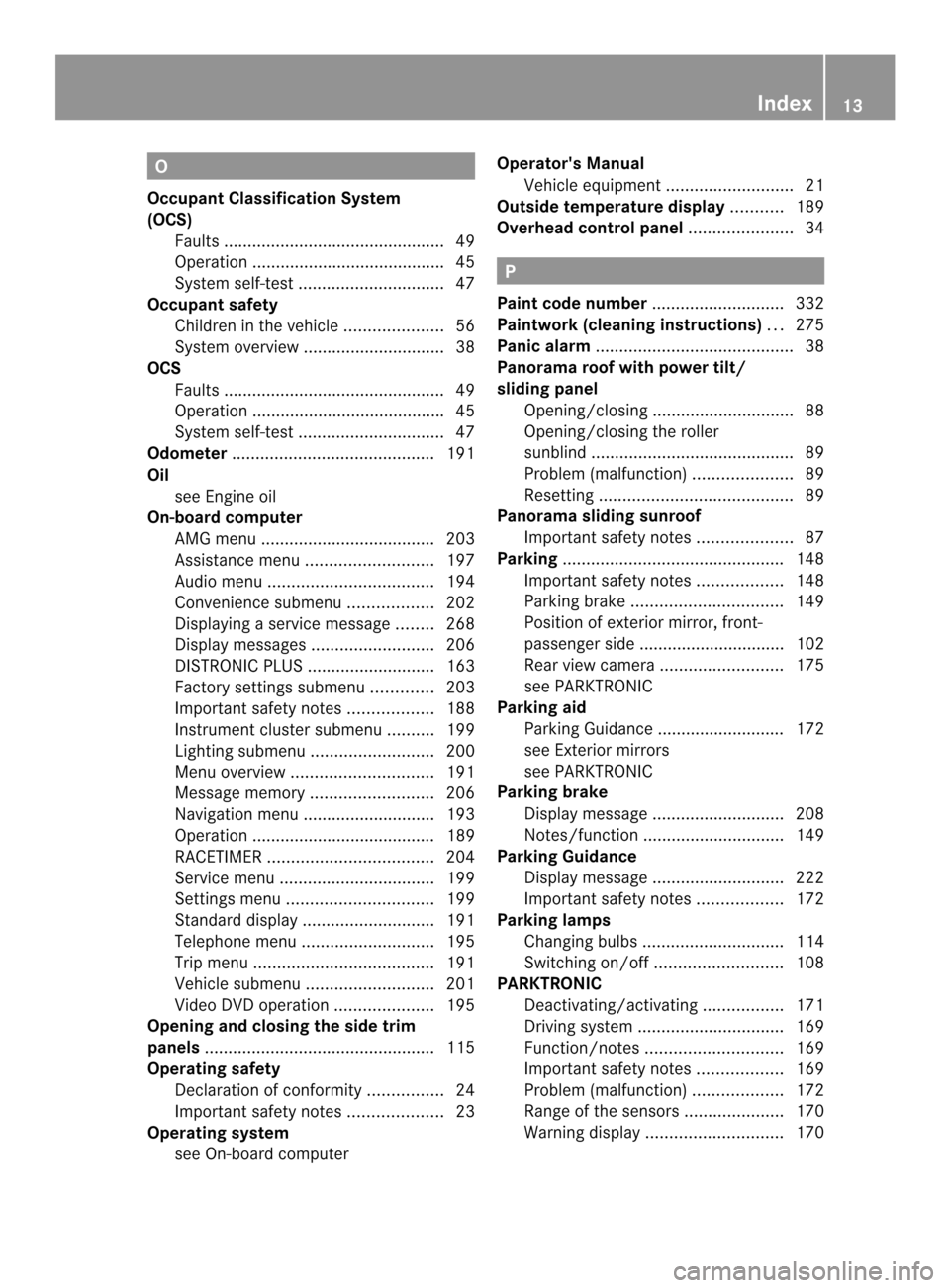
O
Occupant Classification System
(OCS) Faults .............................................. .49
Operation ........................................ .45
System self-test ............................... 47
Occupant safety
Childre ninthe vehicle ..................... 56
System overview .............................. 38
OCS
Faults ............................................... 49
Operation ........................................ .45
System self-test ............................... 47
Odometer ........................................... 191
Oil see Engine oil
On-board computer
AMG menu ..................................... 203
Assistance menu ........................... 197
Audi omenu ................................... 194
Convenience submenu ..................202
Displaying a service message ........268
Display messages ..........................206
DISTRONI CPLUS ........................... 163
Factory settings submenu .............203
Important safety notes ..................188
Instrument cluster submenu ..........199
Lighting submenu .......................... 200
Menu overview .............................. 191
Message memory .......................... 206
Navigation menu ............................ 193
Operation ....................................... 189
RACETIMER ................................... 204
Service menu ................................. 199
Settings menu ............................... 199
Standard displa y............................ 191
Telephone menu ............................ 195
Trip menu ...................................... 191
Vehicle submenu ........................... 201
Video DVD operatio n..................... 195
Opening and closing the side trim
panels ................................................. 115
Operating safety Declaratio nofconformity ................ 24
Important safety notes ....................23
Operating system
see On-board computer Operator's Manual
Vehicle equipment ...........................21
Outside temperature display ...........189
Overhead control panel ......................34 P
Pain tcode number ............................ 332
Paintwork (cleaning instructions) ...275
Panic alarm .......................................... 38
Panorama roof with power tilt/
sliding panel
Opening/closing .............................. 88
Opening/closing the roller
sunblind ........................................... 89
Problem (malfunction) .....................89
Resetting ......................................... 89
Panorama sliding sunroof
Important safety notes ....................87
Parking ............................................... 148
Important safety notes ..................148
Parking brake ................................ 149
Position of exterior mirror, front-
passenger side ............................... 102
Rea rview camera .......................... 175
see PARKTRONIC
Parking aid
Parking Guidance ........................... 172
see Exterior mirrors
see PARKTRONIC
Parking brake
Display message ............................ 208
Notes/function .............................. 149
Parking Guidance
Display message ............................ 222
Important safety notes ..................172
Parking lamps
Changing bulbs .............................. 114
Switching on/off ........................... 108
PARKTRONIC
Deactivating/activating .................171
Driving system ............................... 169
Function/notes ............................. 169
Important safety notes ..................169
Problem (malfunction) ...................172
Range of the sensors .....................170
Warning displa y............................. 170 Index
13
Page 17 of 342
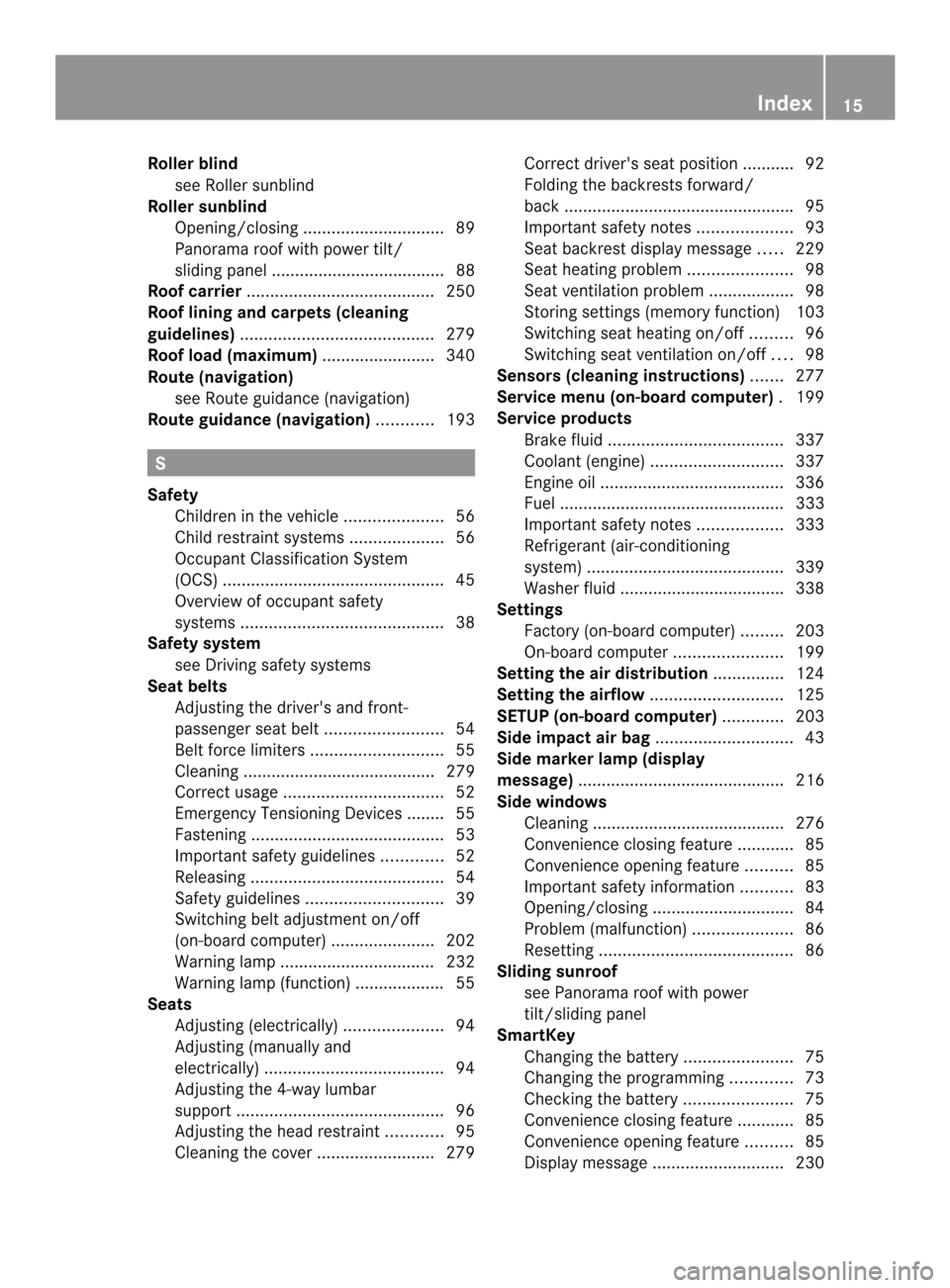
Rolle
rblind
see Roller sunblind
Roller sunblind
Opening/closin g.............................. 89
Panorama roof with power tilt/
sliding panel ..................................... 88
Roof carrier ........................................ 250
Roof lining and carpets (cleaning
guidelines) ......................................... 279
Roof load (maximum) ........................340
Route (navigation) see Route guidance (navigation)
Route guidance (navigation) ............193 S
Safety Childre ninthe vehicle ..................... 56
Child restraint systems ....................56
Occupant Classification System
(OCS) ............................................... 45
Overview of occupant safety
systems ........................................... 38
Safety system
see Driving safety systems
Seat belts
Adjusting the driver's and front-
passenger sea tbelt ......................... 54
Belt force limiters ............................ 55
Cleaning ......................................... 279
Correct usage .................................. 52
Emergency Tensioning Devices ....... .55
Fastening ......................................... 53
Important safety guidelines .............52
Releasing ......................................... 54
Safety guidelines ............................. 39
Switching belt adjustment on/off
(on-board computer) ......................202
Warning lamp ................................. 232
Warning lamp (function) ................... 55
Seats
Adjusting (electrically). ....................94
Adjusting (manually and
electrically). ..................................... 94
Adjusting the 4-way lumbar
support ............................................ 96
Adjusting the head restraint ............95
Cleaning the cover .........................279Correct driver's seat position ........... 92
Folding the backrests forward/
back ................................................
.95
Important safety notes ....................93
Seat backres tdisplay message .....229
Seat heating problem ......................98
Seat ventilation problem ..................98
Storing settings (memory function) 103
Switching sea theating on/off .........96
Switching sea tventilation on/off ....98
Sensors (cleaning instructions) .......277
Service menu (on-board computer) .199
Service products Brake fluid ..................................... 337
Coolant (engine) ............................ 337
Engine oil ....................................... 336
Fuel ................................................ 333
Important safety notes ..................333
Refrigerant (air-conditioning
system) .......................................... 339
Washer fluid .................................. .338
Settings
Factory (on-board computer) .........203
On-board computer .......................199
Setting the air distribution ...............124
Setting the airflow ............................125
SETUP (on-board computer) .............203
Side impact air bag .............................43
Side marker lamp (display
message) ............................................ 216
Side windows Cleaning ......................................... 276
Convenience closing feature ............85
Convenience opening feature ..........85
Important safety information ...........83
Opening/closing .............................. 84
Problem (malfunction) .....................86
Resetting ......................................... 86
Sliding sunroof
see Panorama roof with power
tilt/sliding panel
SmartKey
Changing the battery .......................75
Changing the programming .............73
Checking the battery .......................75
Convenience closing feature ............85
Convenience opening feature ..........85
Display message ............................ 230 Index
15
Page 20 of 342
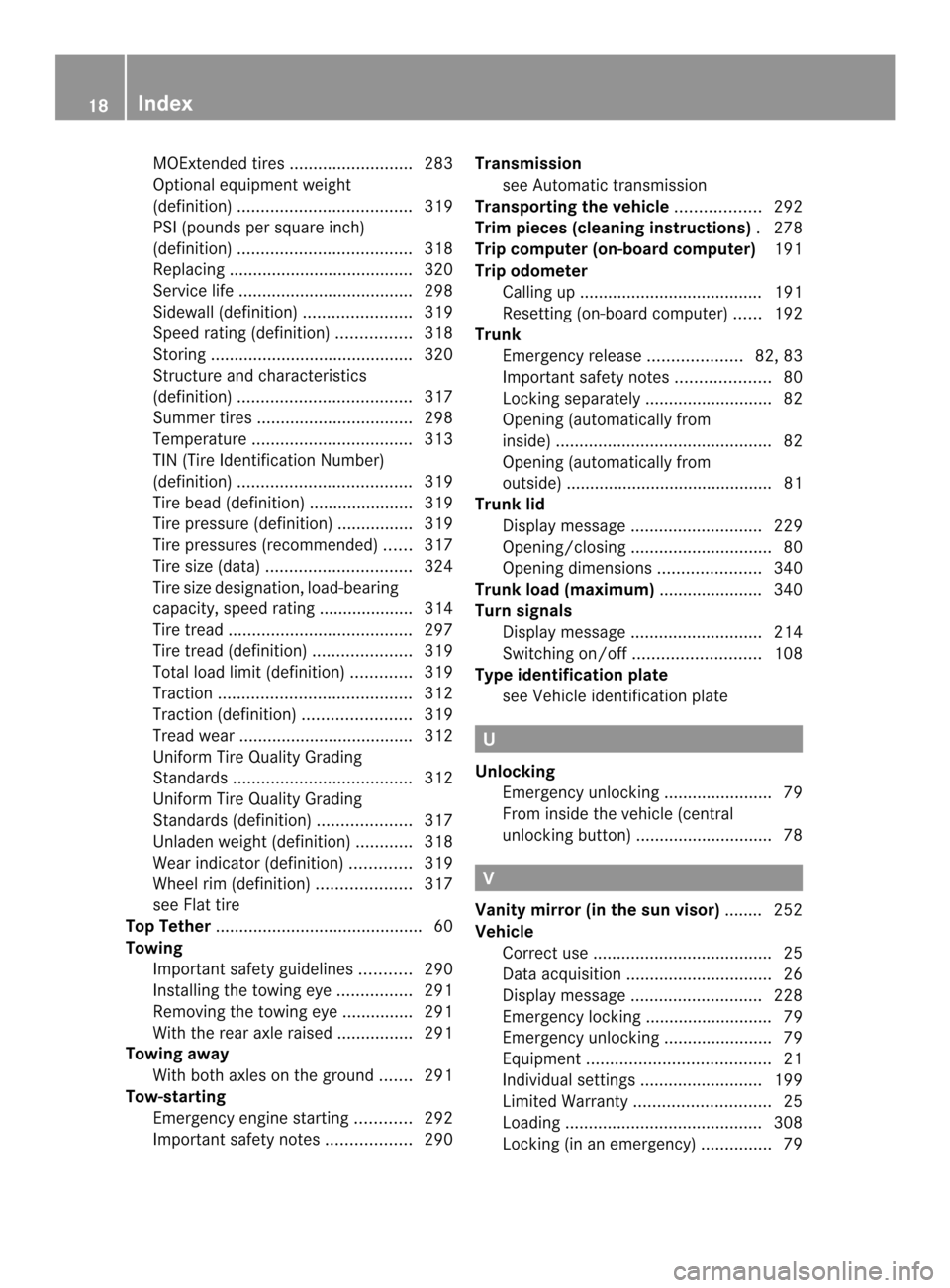
MOExtended tires
..........................283
Optional equipment weight
(definition) ..................................... 319
PSI (pounds per square inch)
(definition) ..................................... 318
Replacing ....................................... 320
Service life ..................................... 298
Sidewall (definition) .......................319
Speed rating (definition) ................318
Storing ........................................... 320
Structure and characteristics
(definition) ..................................... 317
Summer tires ................................. 298
Temperature .................................. 313
TIN (Tire Identification Number)
(definition) ..................................... 319
Tire bea d(definition) ...................... 319
Tire pressure (definition) ................319
Tire pressures (recommended )...... 317
Tire size (data) ............................... 324
Tire size designation, load-bearing
capacity, speed rating .................... 314
Tire tread ....................................... 297
Tire tread (definition) .....................319
Total load limit (definition) .............319
Traction ......................................... 312
Traction (definition) .......................319
Trea dwear ..................................... 312
Uniform Tire Quality Grading
Standard s...................................... 312
Uniform Tire Quality Grading
Standard s(definition) .................... 317
Unladen weight (definition) ............318
Wea rindicato r(definition) .............319
Whee lrim (definition ).................... 317
see Flat tire
Top Tether ............................................ 60
Towing Important safety guidelines ...........290
Installing the towing eye ................291
Removing the towing eye. ..............291
With the rear axle raised ................291
Towing away
With both axles on the ground .......291
Tow-starting
Emergency engine starting ............292
Important safety notes ..................290Transmission
see Automatic transmission
Transporting the vehicle ..................292
Trim pieces (cleaning instructions) .278
Trip computer (on-board computer) 191
Trip odometer Calling up ....................................... 191
Resetting (on-board computer) ......192
Trunk
Emergency release ....................82, 83
Important safety notes ....................80
Locking separatel y........................... 82
Opening (automatically from
inside) .............................................. 82
Opening (automatically from
outside) ............................................ 81
Trunk lid
Display message ............................ 229
Opening/closing .............................. 80
Opening dimensions ......................340
Trunk load (maximum) ......................340
Turn signals Display message ............................ 214
Switching on/off ........................... 108
Type identification plate
see Vehicle identification plate U
Unlocking Emergency unlocking .......................79
From inside the vehicle (central
unlocking button) ............................. 78 V
Vanity mirror (in the sun visor) ........252
Vehicle Correct use ...................................... 25
Data acquisition ............................... 26
Display message ............................ 228
Emergency locking ........................... 79
Emergency unlocking .......................79
Equipment ....................................... 21
Individua lsettings .......................... 199
Limited Warranty ............................. 25
Loading .......................................... 308
Locking (in an emergency) ...............79 18
Index
Page 26 of 342
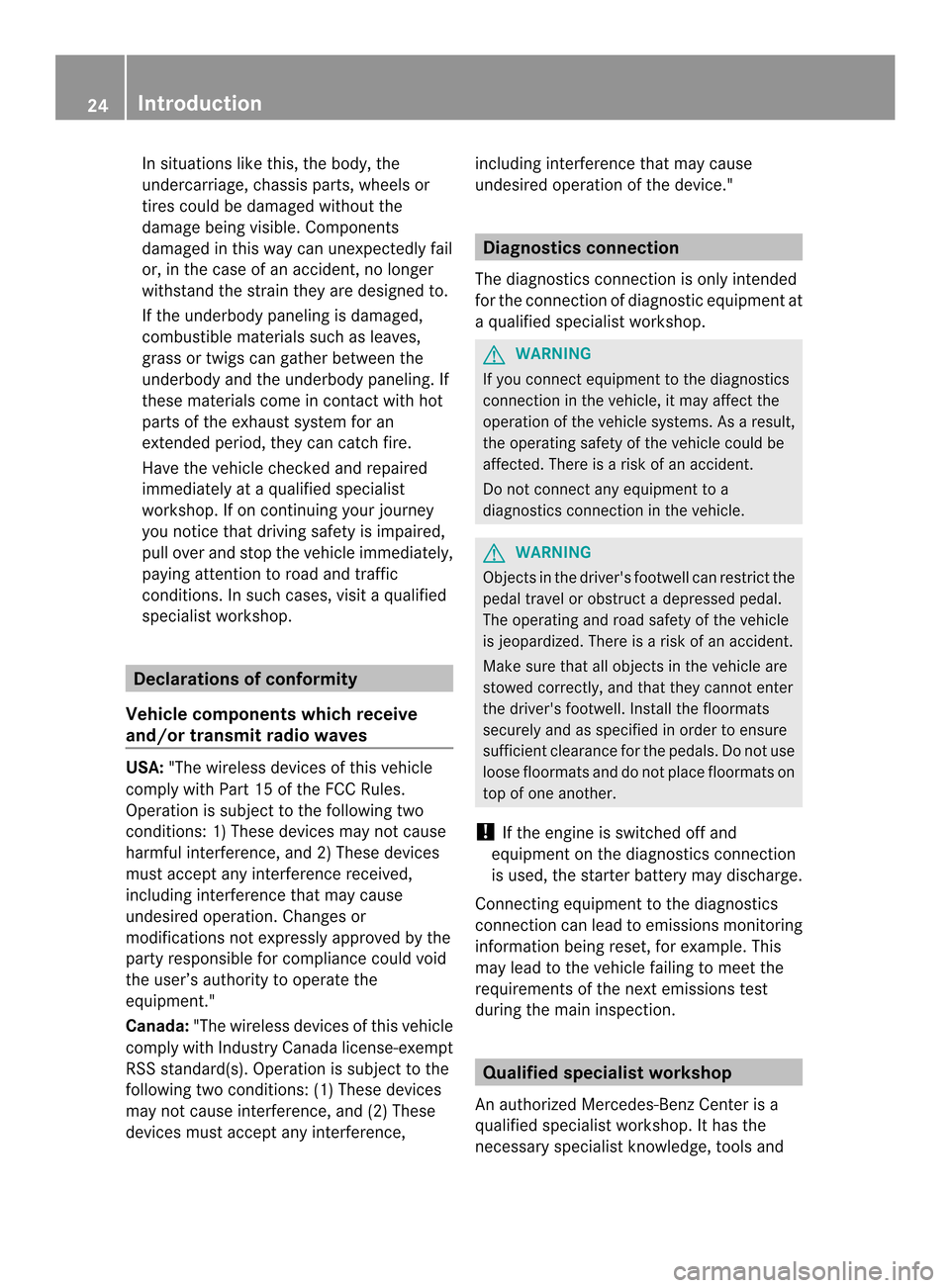
In situations like this, the body, the
undercarriage, chassis parts, wheels or
tires could be damaged withou
tthe
damage being visible. Components
damaged in this way can unexpectedly fail
or, in the case of an accident, no longer
withstand the strain they are designed to.
If the underbody paneling is damaged,
combustible materials such as leaves,
grass or twigs can gather between the
underbody and the underbody paneling. If
these materials come in contact with hot
parts of the exhaust system for an
extended period, they can catch fire.
Have the vehicle checked and repaired
immediately at a qualified specialist
workshop. If on continuing your journey
you notice that driving safety is impaired,
pull over and stop the vehicle immediately,
paying attention to road and traffic
conditions. In such cases, visit a qualified
specialist workshop. Declarations of conformity
Vehicle components which receive
and/or transmit radio waves USA:
"The wireless devices of this vehicle
comply with Part 15 of the FCC Rules.
Operation is subject to the following two
conditions: 1) These devices may not cause
harmful interference, and 2) These devices
must accept any interference received,
including interference that may cause
undesired operation. Changes or
modifications not expressly approved by the
party responsible for compliance could void
the user’s authority to operate the
equipment."
Canada: "The wireless devices of this vehicle
comply with Industry Canada license-exempt
RSS standard(s). Operation is subject to the
following two conditions: (1) These devices
may not cause interference, and (2) These
devices must accept any interference, including interference that may cause
undesired operation of the device." Diagnostics connection
The diagnostics connection is only intended
for the connection of diagnostic equipment at
a qualified specialist workshop. G
WARNING
If you connect equipment to the diagnostics
connection in the vehicle, it may affect the
operation of the vehicle systems. As a result,
the operating safety of the vehicle could be
affected. There is a risk of an accident.
Do not connect any equipment to a
diagnostics connection in the vehicle. G
WARNING
Objects in the driver's footwell can restrict the
pedal travel or obstruct adepressed pedal.
The operating and road safety of the vehicle
is jeopardized. There is a risk of an accident.
Make sure that all objects in the vehicle are
stowed correctly, and that they cannot enter
the driver's footwell. Install the floormats
securely and as specified in order to ensure
sufficien tclearance for the pedals. Do not use
loose floormats and do not place floormats on
top of one another.
! If the engine is switched off and
equipmen tonthe diagnostics connection
is used, the starter battery may discharge.
Connecting equipment to the diagnostics
connection can lead to emissions monitoring
information being reset, for example. This
may lead to the vehicle failing to meet the
requirements of the next emissions test
during the main inspection. Qualified specialist workshop
An authorized Mercedes-Ben zCenter is a
qualified specialist workshop. It has the
necessary specialist knowledge, tools and 24
Introduction
Page 46 of 342

The side impact air bag on the front-
passenger side will deploy if the front-
passenger seat belt is fastened, regardless of
whether the front-passenger seat is occupied
or not.
Pelvis air bags
G
WARNING
Only use seat covers which have been tested
and approved by Mercedes-Benz for your
vehicle model. Using seat covers or other seat
coverings can cause a malfunction of the side
impact air bags and/or the pelvis air bags.
Contact an authorized Mercedes-Benz Center
for availability.
Pelvis air bag deployment enhances the level
of protection of the vehicle occupants on the
side of the vehicle on which the impact
occurs. Pelvis air bags
0002deploy next to and below
the outer seat cushions. They are deployed:
R on the side on which an impact occurs
R at the start of an accident with a high rate
of lateral vehicle deceleration or
acceleration, e.g. in aside impact
R independently of the use of the seat belt
R independently of the front air bags
R independently of the ETDs
Pelvis air bags 0002will not deploy in side
impacts which do not exceed the system's
prese tdeployment thresholds for lateral
acceleration/deceleration .You will then be
protected by the fastened seat belt. The pelvis air bag on the front-passenger side
is not deployed in the following situations:
R
OCS has detected that the front-passenger
seat is unoccupied.
R the front-passenger seat belt is not
fastened.
The pelvis air bag on the front-passenger side
will deploy if the front-passenger seat belt is
fastened, regardless of whether the front-
passenger seat is occupied or not.
Window curtain air bags The window curtain air bags enhance the level
of protection for the head, but not chest or
arms, of the vehicle occupants on the side of
the vehicle on which the impact occurs.
The window curtain air bags are integrated
into the side of the roof frame and deploy in
the area extending from the front door (A-
pillar) to the rear sidewall (C-pillar).
Window curtain air bags
0002are deployed:
R on the side on which an impact occurs
R at the start of an accident with a high rate
of lateral vehicle deceleration or
acceleration, e.g. in aside impact
R regardless of whether the front-passenger
seat is occupied
R independently of the use of the seat belt
R independently of the front air bags
Window curtain air bags 0002will not deploy in
the even tofimpacts which do not exceed the
system's preset deployment thresholds for 44
Occupant safetySafety
Page 52 of 342
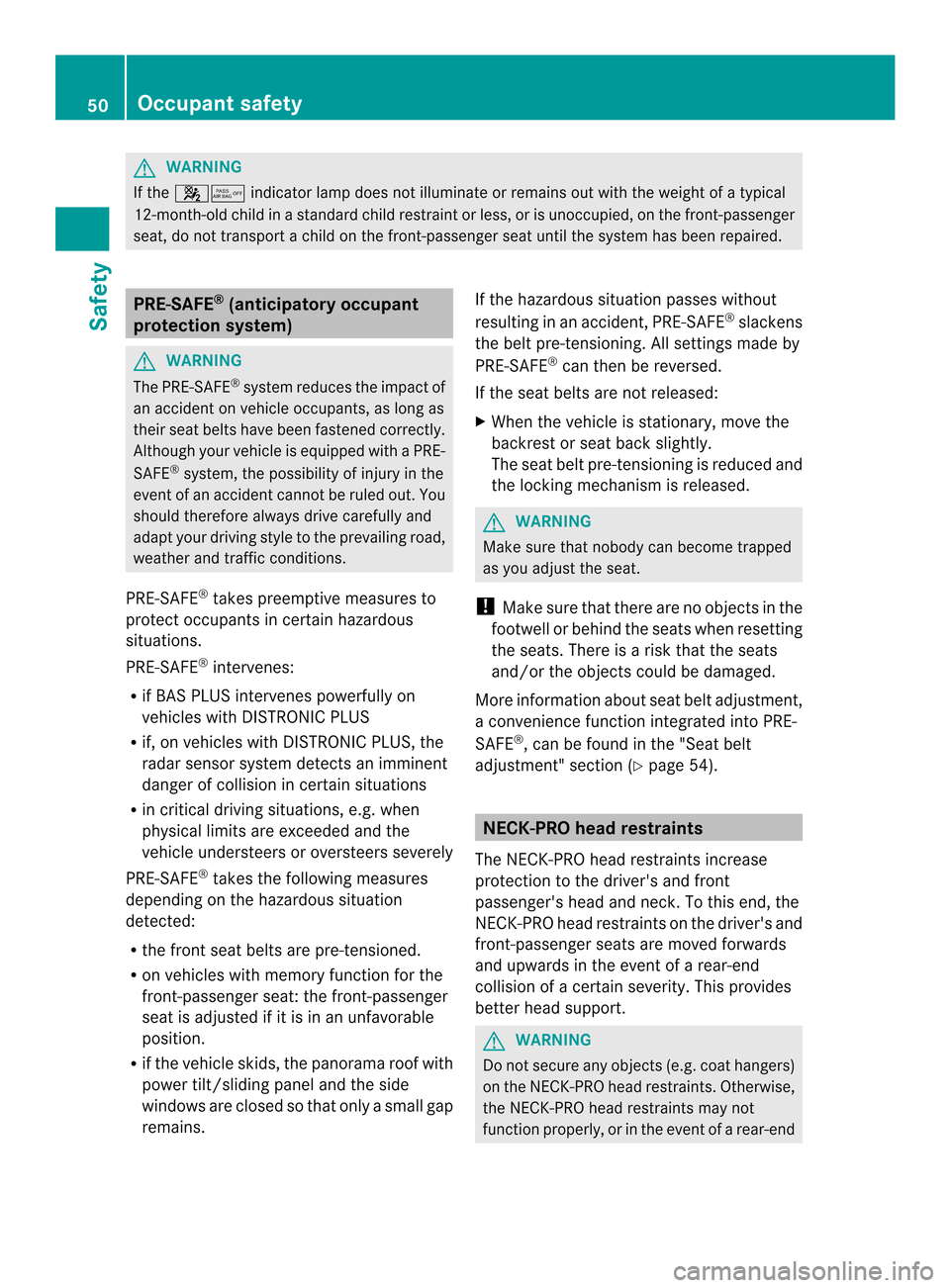
G
WARNING
If the 0019001B indicator lamp does not illuminate or remains out with the weight of a typical
12-month-old child in a standard child restraint or less, or is unoccupied, on the front-passenger
seat, do not transport achild on the front-passenger seat until the system has been repaired. PRE-SAFE
®
(anticipatory occupant
protection system) G
WARNING
The PRE-SAFE ®
system reduces the impact of
an accident on vehicle occupants, as long as
their seat belts have been fastened correctly.
Although your vehicle is equipped with a PRE-
SAFE ®
system, the possibility of injury in the
event of an accident cannot be ruled out. You
should therefore always drive carefully and
adapt your driving style to the prevailing road,
weather and traffic conditions.
PRE-SAFE ®
takes preemptive measures to
protect occupants in certain hazardous
situations.
PRE-SAFE ®
intervenes:
R if BAS PLUS intervenes powerfully on
vehicles with DISTRONIC PLUS
R if, on vehicles with DISTRONIC PLUS, the
radar sensor system detects an imminent
danger of collision in certain situations
R in critical driving situations, e.g. when
physical limits are exceeded and the
vehicle understeers or oversteers severely
PRE-SAFE ®
takes the following measures
depending on the hazardous situation
detected:
R the front seat belts are pre-tensioned.
R on vehicles with memory function for the
front-passenger seat: the front-passenger
seat is adjusted if it is in an unfavorable
position.
R if the vehicle skids, the panorama roof with
power tilt/sliding panel and the side
windows are closed so that only a small gap
remains. If the hazardous situation passes without
resulting in an accident, PRE-SAFE
®
slackens
the belt pre-tensioning. All settings made by
PRE-SAFE ®
can then be reversed.
If the seat belts are not released:
X When the vehicle is stationary, move the
backrest or seat back slightly.
The seat belt pre-tensioning is reduced and
the locking mechanism is released. G
WARNING
Make sure that nobody can become trapped
as you adjust the seat.
! Make sure that there are no objects in the
footwell or behind the seats when resetting
the seats. There is a risk that the seats
and/or the objects could be damaged.
More information about seat belt adjustment,
a convenience function integrated into PRE-
SAFE ®
, can be found in the "Seat belt
adjustment" section (Y page 54). NECK-PRO head restraints
The NECK-PRO head restraints increase
protection to the driver's and front
passenger's head and neck.T o this end, the
NECK-PRO head restraints on the driver's and
front-passenger seats are moved forwards
and upwards in the event of a rear-end
collision of a certain severity. This provides
better head support. G
WARNING
Do not secure any objects (e.g. coat hangers)
on the NECK-PRO head restraints. Otherwise,
the NECK-PRO head restraints may not
function properly, or in the event of a rear-end 50
Occupant safetySafety
Page 53 of 342

collision may not be able offe
rthe level of
protection they are designed to provide. G
WARNING
Seat or head restraint covers can cause a
malfunction when the NECK-PRO head
restraints are activated or when the side
impact air bags or pelvis air bags are
deployed, or they can prevent this completely.
The NECK-PRO head restraints or side impact
air bags/pelvis air bags can therefore not
provide the intended protection. Do not use
any seat or head restraint covers. G
WARNING
For your protection, drive only with properly
positioned head restraints.
Adjust the head restraint so that it is as close
to the head as possible and the center of the
head restraint supports the back of the head
at eye level. This will reduce the potential for
injury to the head and neck in the event of an
accident or similar situation. G
WARNING
For safety reasons, have the NECK-PRO head
restraints checked at a qualified specialist
workshop after a rear-end collision.
The NECK-PRO head restraints reduce the
likelihood of head and chest injuries. The
NECK-PRO head restraints on the driver's and
front-passenger seats are moved forwards
and upwards in the event of a rear-end
collision of a certain severity. This provides
better head support.
If the NECK-PRO head restraints have been
triggered in an accident, reset the NECK-PRO
head restraints on the driver’s and front-
passenger seat (Y page 51). Otherwise, the
additional protection will not be available in
the event of another rear-end collision. You
can recognize if NECK-PRO head restraints
have been triggered by the fact that they have
moved forwards and can no longer be
adjusted. Resetting triggered NECK-PRO head
restraints/NECK-PRO luxury head
restraints
G
WARNING
For safety reasons, have the NECK-PRO head
restraints checked at an authorized
Mercedes-Benz Center after a rear-end
collision. G
WARNING
When pushing back the NECK-PRO head
restraint cushion, make sure your fingers do
not become caught between the head
restraint cushion and the cover. Failure to
observe this could result in injuries.
i Resetting the NECK-PRO head restraints
requires a lot of strength. If you have
difficulty resetting the NECK-PRO head
restraints, have this work carried out at a
qualified specialist workshop. X
Tilt the top of the NECK-PRO head restraint
cushion forwards in the direction of
arrow 0002.
X Push the NECK-PRO head restraint cushion
down in the direction of arrow 0003as far as
it will go.
X Firmly push the NECK-PRO head restraint
cushion back in the direction of arrow 0022
until the cushion engages.
X Repeatt his procedure for the second
NECK-PRO head restraint. Occupant safety
51Safety Z
Page 55 of 342
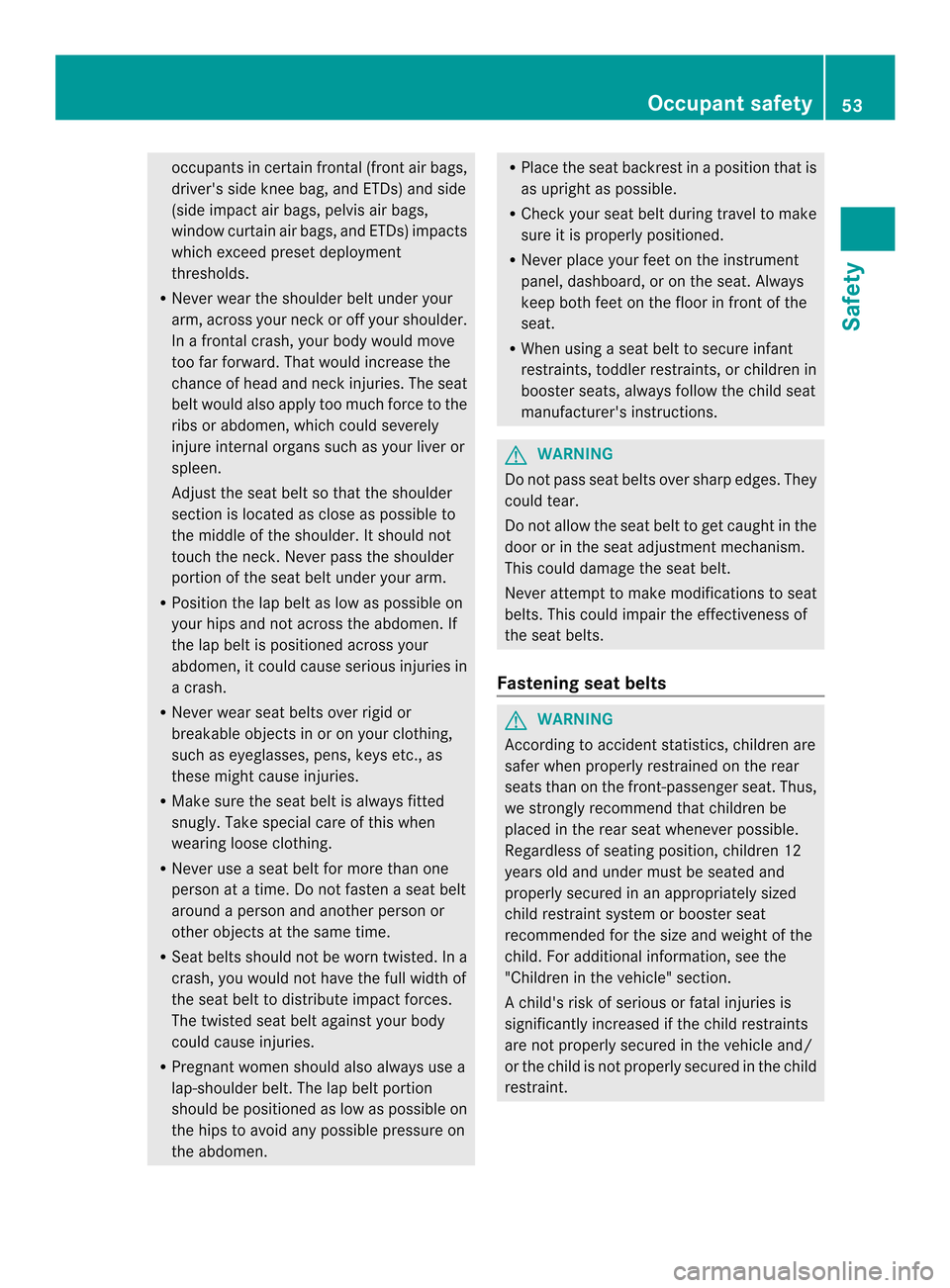
occupants in certain frontal (front air bags,
driver's side knee bag, and ETDs) and side
(side impact air bags, pelvis air bags,
window curtain air bags, and ETDs) impacts
which exceed preset deployment
thresholds.
R Never wear the shoulder belt under your
arm, across your neck or off your shoulder.
In a frontal crash, your body would move
too far forward. That would increase the
chance of head and neck injuries. The seat
belt would also apply too much force to the
ribs or abdomen, which could severely
injure internal organs such as your liver or
spleen.
Adjust the seat belt so that the shoulder
section is located as close as possible to
the middle of the shoulder. It should not
touch the neck.N ever pass the shoulder
portion of the seat belt under your arm.
R Position the lap belt as low as possible on
your hips and not across the abdomen. If
the lap belt is positioned across your
abdomen, it could cause serious injuries in
a crash.
R Never wear seat belts over rigid or
breakable objects in or on your clothing,
such as eyeglasses, pens, keys etc., as
these might cause injuries.
R Make sure the seat belt is always fitted
snugly. Take special care of this when
wearing loose clothing.
R Never use a seat belt for more than one
person at a time. Do not fasten a seat belt
around a person and another person or
other objects at the same time.
R Seat belts should not be worn twisted. In a
crash, you would not have the full width of
the seat belt to distribut eimpact forces.
The twisted seat belt against yourb ody
could cause injuries.
R Pregnant women should also always use a
lap-shoulder belt. The lap belt portion
should be positioned as low as possible on
the hips to avoid any possible pressure on
the abdomen. R
Place the seat backrest in a position that is
as upright as possible.
R Check your seat belt during travel to make
sure it is properly positioned.
R Never place your feet on the instrument
panel, dashboard, or on the seat. Always
keep both feet on the floor in front of the
seat.
R When using a seat belt to secure infant
restraints, toddler restraints, or children in
booster seats, always follow the child seat
manufacturer's instructions. G
WARNING
Do not pass seat belts over sharp edges. They
could tear.
Do not allow the seat belt to get caught in the
door or in the seat adjustment mechanism.
This could damage the seat belt.
Never attempt to make modifications to seat
belts. This could impair the effectiveness of
the seat belts.
Fastening seat belts G
WARNING
According to accident statistics, children are
safer when properly restrained on the rear
seats than on the front-passenger seat. Thus,
we strongly recommend that children be
placed in the rear seat whenever possible.
Regardless of seating position, children 12
years old and under must be seated and
properly secured in an appropriately sized
child restraint system or booster seat
recommended for the size and weight of the
child. For additional information, see the
"Children in the vehicle" section.
Ac hild's risk of serious or fatal injuries is
significantly increased if the child restraints
are not properly secured in the vehicle and/
or the child is not properly secured in the child
restraint. Occupant safety
53Safety Z